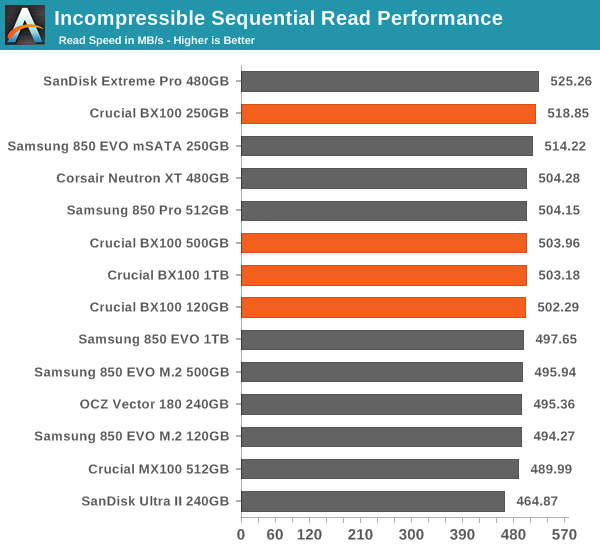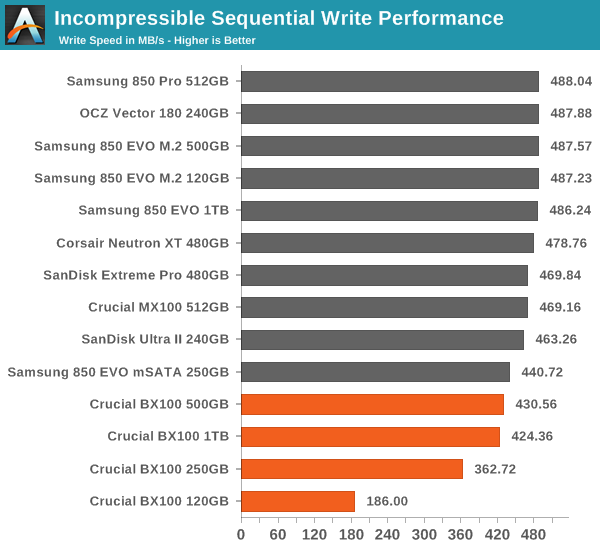Crucial BX100 (120GB, 250GB, 500GB & 1TB) SSD Review
by Kristian Vättö on April 10, 2015 1:20 PM EST- Posted in
- Storage
- SSDs
- Crucial
- Micron
- Silicon Motion
- BX100
- SM2246EN
- Micron 16nm
ATTO - Transfer Size vs Performance
ATTO is a handy tool for quickly measuring performance across various transfer sizes and it's also freeware that can easily be run by the end-user.
 |
|||||||||
AS-SSD Incompressible Sequential Performance
Similar to ATTO, AS-SSD is freeware as well and uses incompressible data for all of its transfers, making it a valuable tool when testing drives with built-in compression engines (e.g. SandForce).












67 Comments
View All Comments
Kristian Vättö - Saturday, April 11, 2015 - link
We've run some basic tests, but nothing too in-depth for the review. Testing an internal drive is a bit more complicated, but hopefully we'll be able to follow up with more thorough testing once we get the initial review out.repoman27 - Saturday, April 11, 2015 - link
Especially when it's not just internal but full on embedded. We may need to wait for an iFixit or Chipworks teardown to get a better picture of how this is implemented.zodiacfml - Saturday, April 11, 2015 - link
I'd take the Samsung with longer warranty and fat pixels... i mean, NAND. The 250GB version has more DRAM compared to the BX100 if that is any useful.Random read/write is what differentiates these great products.
zodiacfml - Saturday, April 11, 2015 - link
Speaking of random performance, isn't the random read results swapped with the random write chart?digiguy - Friday, April 10, 2015 - link
Agree with Christian, the limitations of SATA 6GB hardly justify an SSD like the 850 pro or the Extreme pro (which I have), especially with PCIe virtually here (tough still rare in laptops). Something like this SSD (or the MX100 which I also have is perfectly adequate even for enthusiasts). I even wonder how many years the SATA interface will survive... I suspect that in 10 years SATA SSDs might well be a thing of the past... (especially in the 2.5 inches format...).CaedenV - Friday, April 10, 2015 - link
I think it depends on the use. I would imagine that SSDs are going to transition to M.2 or embedded options as the primary interface. However, I think that SATA, even SATA3, has a very long life ahead as a traditional HDD interface for bulk storage. My bet is that we will see 1-2 M.2 connectors for system drive SSDs, and continue to see 2-4 SATA connectors with RAID support for HDD installs for a very long time. They simply do not cost much, and they don't take a lot of space, so it will sort of be like how PS/2 ports keep showing up even though practically nobody uses them, or how parallel ports hung on a good 10 years after they were useful.Murloc - Saturday, April 11, 2015 - link
kb-0133s never die, and so neither does PS/2.lordken - Sunday, April 12, 2015 - link
I do use PS/2, as long as my old M$ multimedia keyboard is going to live...no reason to buy new usb keyboard only because this one is like 10y old :)Also using good old mx518 (which is usb ofc)
Jaybus - Thursday, April 16, 2015 - link
I don't think multiple M.2 connections will be likely. A single M.2 is great for small form factors, but it takes up too much board space.Pissedoffyouth - Friday, April 10, 2015 - link
Awesoem stuff. I have an mSata m500 and its been flawless, unlike the bad performance I've had with samsung 840's.Looks like this is the drive to recommend to people, I might even get myself one of the 250gb as portable drive